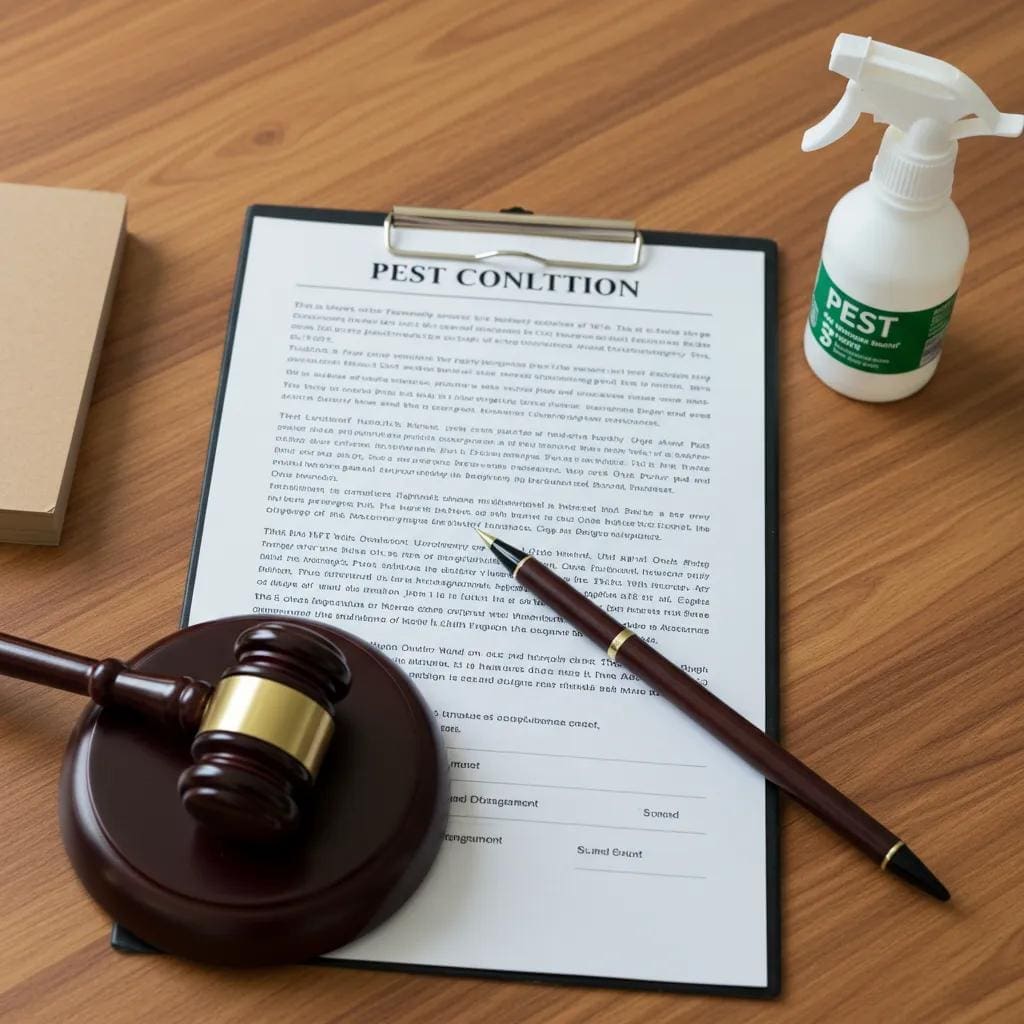
Landlord Pest Control Responsibilities UK: Who's Accountable and How to Manage Rental Property Pest Control
A solid grasp of landlord pest control duties keeps rental properties liveable, compliant, and free from infestation risks. This guide offers practical insights into legal duties, clarifies responsibilities between landlords and tenants, examines common pests, outlines proactive prevention methods, and provides a clear action plan for dealing with outbreaks. You’ll explore UK legislation, responsibility charts, key pest profiles, property proofing techniques, criteria for hiring professionals, local services in Maidenhead, and guidance on cost allocation. By mastering these aspects, landlords and letting agents can protect their investments, ensure tenant wellbeing, and maintain smooth tenancy operations.
What Are the Legal Obligations for Landlord Pest Control in the UK?

Landlords are legally bound to ensure rental properties are free from pest infestations, safeguarding health, safety, and structural integrity. This duty stems from various UK laws that set standards for habitability, environmental responsibility, and tenant protection. Meeting these requirements helps avoid enforcement actions, tenant claims, and potential penalties.
Which UK Laws Govern Landlord Pest Control Responsibilities?
Key legislation defines landlord duties, enforcement procedures, and tenant rights. Understanding each act clarifies compliance requirements and shapes pest management strategies.
| Legislation | Scope | Implication for Pest Control |
|---|---|---|
| Landlord and Tenant Act 1985 | Property maintenance and habitable standards | Requires upkeep of structural elements to prevent pest entry |
| Homes (Fitness for Human Habitation) Act 2018 | Habitability and tenant health | Mandates dwellings remain free from hazards, including pests |
| Housing Health and Safety Rating System (HHSRS) | Risk assessment of hazards | Prioritises pest presence as a Category 1 or 2 hazard |
Under these laws, landlords must conduct regular checks, carry out prompt repairs, and demonstrate remedial actions to uphold tenancy agreements.
How Does the Environmental Protection Act 1990 Affect Landlord Pest Control?
The Environmental Protection Act 1990 imposes a duty of care regarding waste and environmental nuisances. It requires landlords to:
- Store and dispose of refuse in secure containers to deter rodents and insects.
- Prevent pest breeding grounds by maintaining external communal areas.
- Cooperate with local authorities on statutory notices concerning environmental health.
By incorporating waste management into pest control plans, landlords minimise triggers for infestations and ensure environmental compliance.
What Are the Consequences of Non-Compliance for Landlords?
Failing to meet pest control obligations can lead to:
- Enforcement notices from local environmental health departments.
- Legal action through housing tribunals, potentially resulting in fines or rent repayment orders.
- Tenant claims for breach of contract and compensation for distress.
- Damage to reputation and reduced property value due to ongoing pest problems.
Taking a proactive approach to pest control protects against these risks and upholds a landlord’s duty of care.
Who Is Responsible for Pest Control: Landlord or Tenant in the UK?
When Is the Landlord Responsible for Pest Control?
Landlords should handle pest control when:
- An infestation is present at the start of a tenancy.
- Structural issues (e.g., gaps, cracks) allow pests to enter.
- Communal areas managed by the landlord have pest problems.
- Statutory health and safety duties necessitate intervention.
Ensuring structural soundness and cleanliness of communal areas prevents delays in addressing infestations caused by tenant issues.
When Does Tenant Responsibility Apply?
Tenants are responsible for pest control when:
- Poor hygiene or waste storage practices attract pests.
- Unauthorised pets lead to fleas or mites.
- Failure to report early signs of infestation allows it to spread.
- Tenancy agreements include clauses on cleanliness and reporting.
Active tenant cooperation helps reduce the severity of infestations and supports landlord prevention efforts.
How to Use a Responsibility Matrix for Pest Control Duties?
A clear matrix outlines scenarios and assigns accountability, simplifying decision-making and cost allocation.
| Scenario | Landlord Role | Tenant Role |
|---|---|---|
| Pre-existing rodent infestation | Arrange and fund professional eradication | Report condition immediately |
| Cracks in external walls | Conduct proofing repairs | Maintain interior cleanliness |
| Bed bug appearance from tenant’s furniture | Coordinate specialist treatment | Provide access and prepare room |
| Shared garden attracting ants | Manage communal pest monitoring and landscaping | Keep personal bins sealed and report any sightings |
What Are the Most Common Pests in UK Rental Properties and Landlord Responsibilities?
How Do Rats and Mice Affect Rental Properties?
Rats and mice can spread diseases, damage electrical wiring, and compromise insulation. Landlord responsibilities include:
- Sealing structural entry points like gaps around pipes.
- Providing vermin-proof refuse containers.
- Arranging professional traps or bait stations.
- Conducting follow-up inspections to confirm eradication.
Effective rodent control prevents costly structural damage and protects tenant health.
What Should Landlords Know About Bed Bug Infestations?
Bed bugs cause discomfort, sleep disruption, and allergic reactions. To manage infestations, landlords must:
- Look for signs like bites, shed skins, and faecal spots.
- Hire certified thermal or chemical treatment specialists.
- Provide tenants with preparation instructions (e.g., washing bedding).
- Schedule follow-up inspections and retreatment if necessary.
Swift bed bug removal maintains tenant satisfaction and prevents spread between properties in multi-unit buildings.
How Are Cockroaches and Ants Managed in Rental Properties?
Cockroaches and ants contaminate food and can trigger allergic reactions. Management involves:
- Eliminating food and water sources by sealing containers and fixing leaks.
- Applying targeted residual insecticides in entry points.
- Using bait stations in communal areas.
- Educating tenants on prompt spill cleanup and proper bin usage.
Combining chemical treatments with sanitation practices disrupts nesting and foraging behaviours.
How Can Landlords Proactively Prevent Pest Infestations in Rental Properties?
What Are Effective Property Inspection Practices for Landlords?
Regular inspections help identify early signs of pests. Best practices include:
- Checking under sinks, in loft spaces, and behind appliances for droppings.
- Examining external walls for cracks, holes, and signs of nesting.
- Reviewing tenant cleaning records and communal area maintenance logs.
- Documenting findings with photos and written reports.
Consistent inspections reveal vulnerabilities before pests establish themselves and require costly eradication.
How Does Structural Proofing Help Prevent Pest Entry?
Structural proofing involves sealing potential entry points and reinforcing barriers. Methods include:
- Filling cracks and gaps with specialised sealants.
- Installing door sweeps and mesh screens on vents.
- Repairing damaged wood and brickwork.
- Ensuring window frames and pipe penetrations are pest-proofed.
These measures block pest pathways and maintain property integrity long after treatment.
What Role Does Tenant Education Play in Pest Prevention?

Educating tenants on hygiene and reporting duties encourages cooperation. Key aspects include:
- Providing clear instructions on waste disposal and cleaning routines.
- Sending seasonal reminders for communal area upkeep.
- Explaining early signs of infestation and how to report them.
- Including pest prevention clauses in tenancy agreements.
Informed tenants support prevention efforts and help speed up responses to emerging issues.
What Steps Should Landlords Take When Responding to a Pest Infestation?
How to Respond Promptly to Tenant Pest Reports?
Acknowledging and addressing reports quickly builds tenant trust. Best practices include:
- Logging reports with the date, time, and description of the issue.
- Scheduling an inspection within 24–48 hours.
- Advising tenants on temporary measures (e.g., securing food).
- Confirming the next steps and arranging professional visits.
Clear communication and swift action demonstrate a commitment to tenant wellbeing and legal compliance.
When Should Professional Pest Control Services Be Engaged?
Professional help is needed when:
- Infestations are too severe for basic DIY solutions.
- Specialised treatments like fumigation or heat treatment are required.
- Structural proofing and ongoing monitoring are part of an integrated management plan.
- Local environmental health notices mandate the use of certified professionals.
Hiring accredited professionals ensures safe, effective eradication and adherence to UK standards.
How to Document and Monitor Pest Control Treatments?
Keeping detailed records proves treatment effectiveness and informs future prevention. Essential steps include:
- Recording service dates, treatment methods, and chemicals used.
- Taking before-and-after photos of affected areas.
- Scheduling follow-up inspections and monitoring visits.
- Keeping copies of all invoices, inspection reports, and service guarantees.
Comprehensive documentation supports regulatory compliance and helps landlords address tenant queries.
What Pest Control Services Are Available for Landlords and Letting Agents in Maidenhead?
How Does Pest Dominion Support Landlords in Maidenhead?
Pest Dominion offers complete solutions designed for rental properties, including:
- Integrated pest management plans with regular monitoring.
- Structural proofing and habitat modification services.
- Certified treatments for rodents, bed bugs, insects, and birds.
- Dedicated account managers for letting agents and landlords.
This local expertise ensures consistent service quality and rapid response across Berkshire.
What Are the Benefits of Integrated Pest Management (IPM) for Rental Properties?
Integrated pest management combines preventative and reactive strategies for sustainable control.
| IPM Component | Practical Advantage | Environmental Benefit |
|---|---|---|
| Regular Monitoring | Early detection of infestations | Minimises pesticide use |
| Habitat Modification | Reduces entry and nesting sites | Preserves biodiversity |
| Targeted Treatments | Focuses on problem areas | Limits non-target organism exposure |
| Performance Review | Adjusts strategies as needed | Encourages continual improvement |
How Can Letting Agents Collaborate with Pest Control Providers?
Effective partnerships streamline property management processes. Letting agents should:
- Incorporate pest control schedules into tenancy handover procedures.
- Share property layout plans and tenant contact information with providers.
- Coordinate joint inspections to address issues in communal areas.
- Maintain central records of treatment history and recommendations.
Collaboration ensures minimal disruption for tenants and provides landlords with comprehensive service feedback.
Who Pays for Pest Control in Rental Properties UK: Landlord or Tenant?
Can Landlords Charge Tenants for Pest Control Services?
Landlords may charge tenants when:
- Tenancy agreements clearly state tenant liability for specific pest treatments.
- Infestations are solely due to tenant negligence or prohibited activities.
- Landlords provide written quotes and receive tenant approval.
Clear clauses and documented authorisations protect both parties and reduce disputes.
How Do Tenancy Agreements Define Pest Control Payment Responsibilities?
Tenancy agreements usually include clauses that:
- Specify landlord responsibility for pre-existing or structural infestations.
- Assign tenant liability for pest issues caused by poor housekeeping or pets.
- Outline cost recovery methods, such as deductions from the deposit.
- Detail notice periods required before arranging treatments.
Well-drafted agreements minimise confusion and facilitate prompt cost resolution.
What Are Common Disputes Over Pest Control Costs and How to Resolve Them?
Disputes often stem from unclear contracts or disagreements about causation. Resolution methods include:
- Reviewing photographic evidence and treatment records.
- Seeking mediation through deposit protection schemes.
- Consulting local environmental health guidance on tenant-landlord duties.
- Updating future agreements with clearer pest responsibility terms.
Proactive contract drafting and open communication prevent escalation and maintain landlord-tenant relationships.
Landlords who adopt these practices maintain compliant, pest-free properties and foster positive tenant relationships. Continuous prevention, rapid response, and clear cost allocation protect investments and ensure long-term tenancy success.

